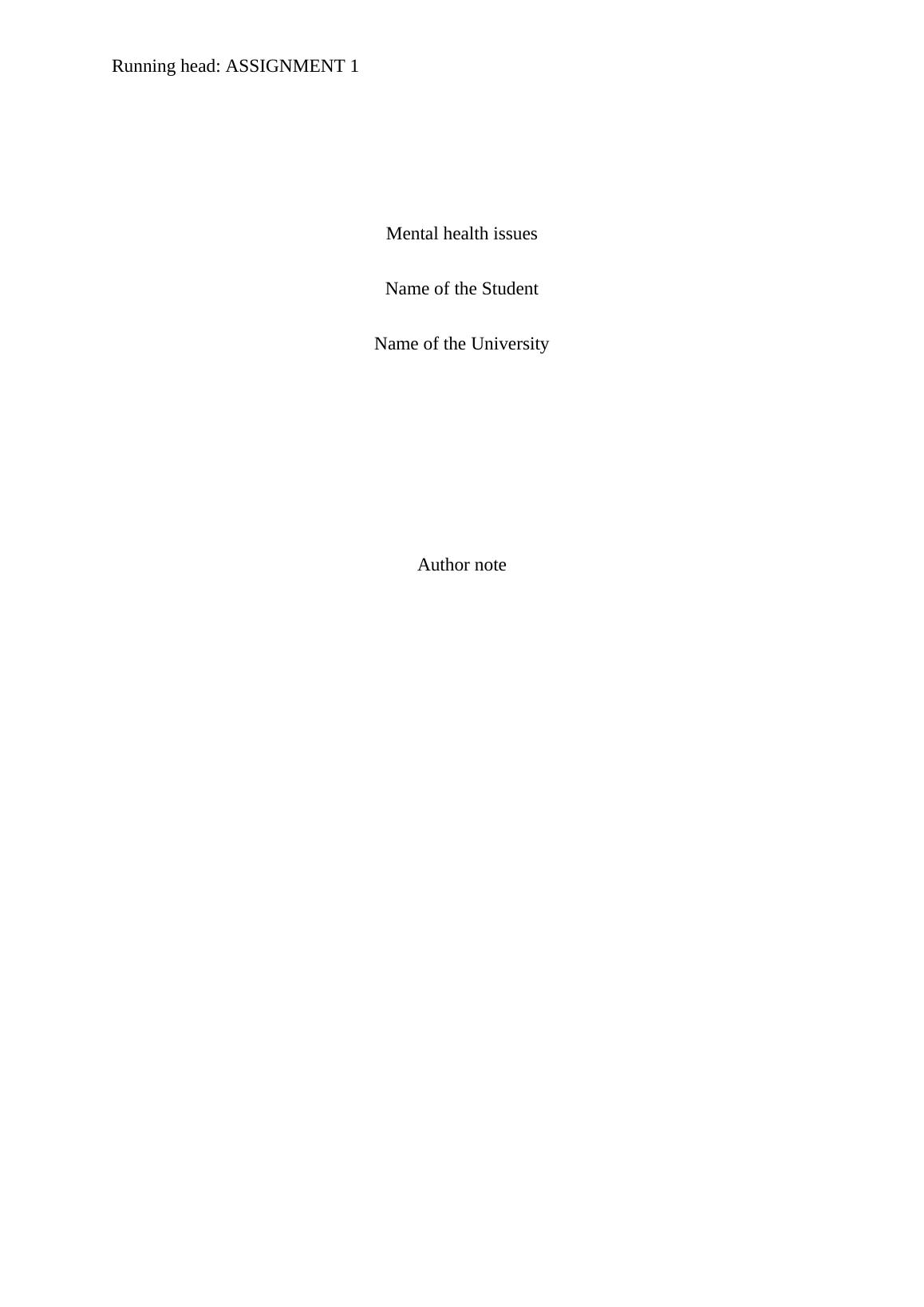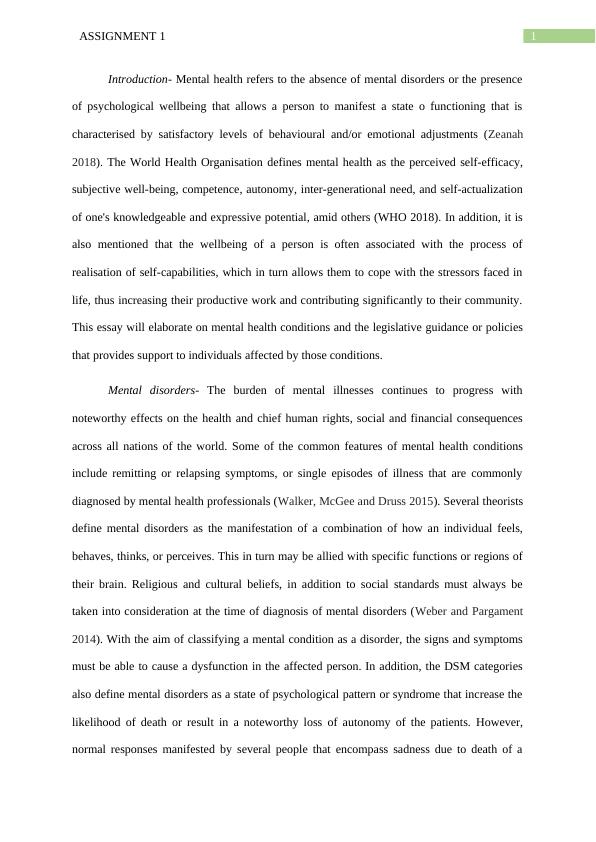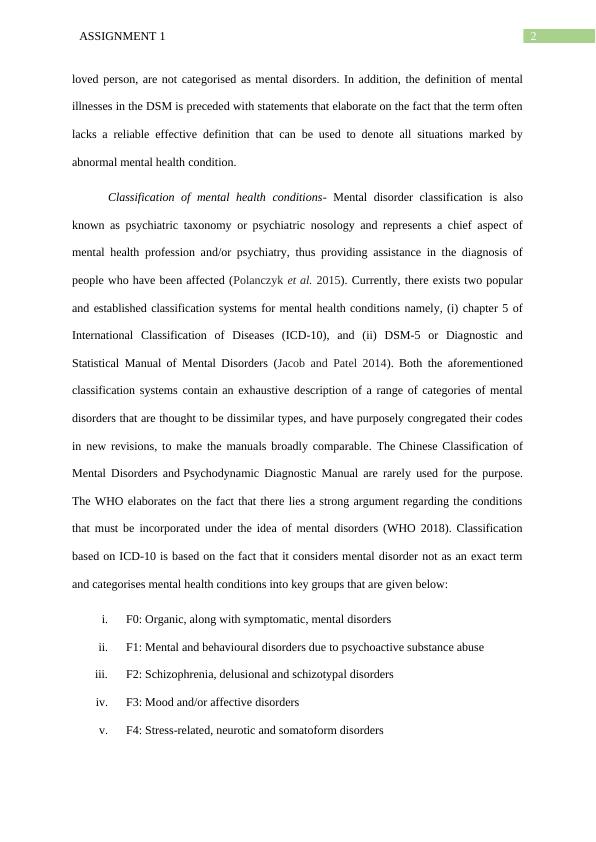Mental Health Issues and Legislative Guidance
Added on 2023-01-16
10 Pages2542 Words20 Views
Running head: ASSIGNMENT 1
Mental health issues
Name of the Student
Name of the University
Author note
Mental health issues
Name of the Student
Name of the University
Author note

1ASSIGNMENT 1
Introduction- Mental health refers to the absence of mental disorders or the presence
of psychological wellbeing that allows a person to manifest a state o functioning that is
characterised by satisfactory levels of behavioural and/or emotional adjustments (Zeanah
2018). The World Health Organisation defines mental health as the perceived self-efficacy,
subjective well-being, competence, autonomy, inter-generational need, and self-actualization
of one's knowledgeable and expressive potential, amid others (WHO 2018). In addition, it is
also mentioned that the wellbeing of a person is often associated with the process of
realisation of self-capabilities, which in turn allows them to cope with the stressors faced in
life, thus increasing their productive work and contributing significantly to their community.
This essay will elaborate on mental health conditions and the legislative guidance or policies
that provides support to individuals affected by those conditions.
Mental disorders- The burden of mental illnesses continues to progress with
noteworthy effects on the health and chief human rights, social and financial consequences
across all nations of the world. Some of the common features of mental health conditions
include remitting or relapsing symptoms, or single episodes of illness that are commonly
diagnosed by mental health professionals (Walker, McGee and Druss 2015). Several theorists
define mental disorders as the manifestation of a combination of how an individual feels,
behaves, thinks, or perceives. This in turn may be allied with specific functions or regions of
their brain. Religious and cultural beliefs, in addition to social standards must always be
taken into consideration at the time of diagnosis of mental disorders (Weber and Pargament
2014). With the aim of classifying a mental condition as a disorder, the signs and symptoms
must be able to cause a dysfunction in the affected person. In addition, the DSM categories
also define mental disorders as a state of psychological pattern or syndrome that increase the
likelihood of death or result in a noteworthy loss of autonomy of the patients. However,
normal responses manifested by several people that encompass sadness due to death of a
Introduction- Mental health refers to the absence of mental disorders or the presence
of psychological wellbeing that allows a person to manifest a state o functioning that is
characterised by satisfactory levels of behavioural and/or emotional adjustments (Zeanah
2018). The World Health Organisation defines mental health as the perceived self-efficacy,
subjective well-being, competence, autonomy, inter-generational need, and self-actualization
of one's knowledgeable and expressive potential, amid others (WHO 2018). In addition, it is
also mentioned that the wellbeing of a person is often associated with the process of
realisation of self-capabilities, which in turn allows them to cope with the stressors faced in
life, thus increasing their productive work and contributing significantly to their community.
This essay will elaborate on mental health conditions and the legislative guidance or policies
that provides support to individuals affected by those conditions.
Mental disorders- The burden of mental illnesses continues to progress with
noteworthy effects on the health and chief human rights, social and financial consequences
across all nations of the world. Some of the common features of mental health conditions
include remitting or relapsing symptoms, or single episodes of illness that are commonly
diagnosed by mental health professionals (Walker, McGee and Druss 2015). Several theorists
define mental disorders as the manifestation of a combination of how an individual feels,
behaves, thinks, or perceives. This in turn may be allied with specific functions or regions of
their brain. Religious and cultural beliefs, in addition to social standards must always be
taken into consideration at the time of diagnosis of mental disorders (Weber and Pargament
2014). With the aim of classifying a mental condition as a disorder, the signs and symptoms
must be able to cause a dysfunction in the affected person. In addition, the DSM categories
also define mental disorders as a state of psychological pattern or syndrome that increase the
likelihood of death or result in a noteworthy loss of autonomy of the patients. However,
normal responses manifested by several people that encompass sadness due to death of a

2ASSIGNMENT 1
loved person, are not categorised as mental disorders. In addition, the definition of mental
illnesses in the DSM is preceded with statements that elaborate on the fact that the term often
lacks a reliable effective definition that can be used to denote all situations marked by
abnormal mental health condition.
Classification of mental health conditions- Mental disorder classification is also
known as psychiatric taxonomy or psychiatric nosology and represents a chief aspect of
mental health profession and/or psychiatry, thus providing assistance in the diagnosis of
people who have been affected (Polanczyk et al. 2015). Currently, there exists two popular
and established classification systems for mental health conditions namely, (i) chapter 5 of
International Classification of Diseases (ICD-10), and (ii) DSM-5 or Diagnostic and
Statistical Manual of Mental Disorders (Jacob and Patel 2014). Both the aforementioned
classification systems contain an exhaustive description of a range of categories of mental
disorders that are thought to be dissimilar types, and have purposely congregated their codes
in new revisions, to make the manuals broadly comparable. The Chinese Classification of
Mental Disorders and Psychodynamic Diagnostic Manual are rarely used for the purpose.
The WHO elaborates on the fact that there lies a strong argument regarding the conditions
that must be incorporated under the idea of mental disorders (WHO 2018). Classification
based on ICD-10 is based on the fact that it considers mental disorder not as an exact term
and categorises mental health conditions into key groups that are given below:
i. F0: Organic, along with symptomatic, mental disorders
ii. F1: Mental and behavioural disorders due to psychoactive substance abuse
iii. F2: Schizophrenia, delusional and schizotypal disorders
iv. F3: Mood and/or affective disorders
v. F4: Stress-related, neurotic and somatoform disorders
loved person, are not categorised as mental disorders. In addition, the definition of mental
illnesses in the DSM is preceded with statements that elaborate on the fact that the term often
lacks a reliable effective definition that can be used to denote all situations marked by
abnormal mental health condition.
Classification of mental health conditions- Mental disorder classification is also
known as psychiatric taxonomy or psychiatric nosology and represents a chief aspect of
mental health profession and/or psychiatry, thus providing assistance in the diagnosis of
people who have been affected (Polanczyk et al. 2015). Currently, there exists two popular
and established classification systems for mental health conditions namely, (i) chapter 5 of
International Classification of Diseases (ICD-10), and (ii) DSM-5 or Diagnostic and
Statistical Manual of Mental Disorders (Jacob and Patel 2014). Both the aforementioned
classification systems contain an exhaustive description of a range of categories of mental
disorders that are thought to be dissimilar types, and have purposely congregated their codes
in new revisions, to make the manuals broadly comparable. The Chinese Classification of
Mental Disorders and Psychodynamic Diagnostic Manual are rarely used for the purpose.
The WHO elaborates on the fact that there lies a strong argument regarding the conditions
that must be incorporated under the idea of mental disorders (WHO 2018). Classification
based on ICD-10 is based on the fact that it considers mental disorder not as an exact term
and categorises mental health conditions into key groups that are given below:
i. F0: Organic, along with symptomatic, mental disorders
ii. F1: Mental and behavioural disorders due to psychoactive substance abuse
iii. F2: Schizophrenia, delusional and schizotypal disorders
iv. F3: Mood and/or affective disorders
v. F4: Stress-related, neurotic and somatoform disorders

End of preview
Want to access all the pages? Upload your documents or become a member.
Related Documents
Psychology Test: Normality and Abnormality, Classification of Mental Disorders, Models of Atypical Behavior and Treatment Optionslg...
|9
|2309
|480
Psychiatric Diagnostic Categories and Its Impactlg...
|13
|3300
|40
PSYC 474 - Family Health and Psychology - Case Studylg...
|13
|3637
|67
Psychology, Biological and social influences of depressionlg...
|11
|3309
|287
Psychological Disorder Research Paper- Schizophrenialg...
|15
|4041
|73
Psychopathological Condition Essaylg...
|10
|2631
|36
